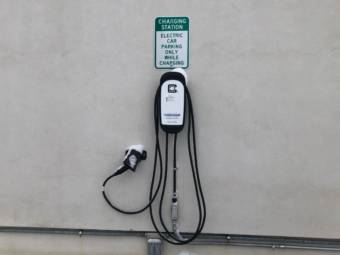
The Alaska Energy Authority plans to install between 10 and 14 electric chargers along the railbelt, from Homer and Seward to Fairbanks. Right now, sparsely distributed charging stations make electric vehicles impractical for long drives in Alaska.
AEA is looking for companies to make those charging stations and sites to host them. It has about $1 million to put toward the project, part of Alaska’s share of a 2017 settlement with Volkswagen over a diesel emissions scandal.
Other states have pledged to use their shares of the settlement money to create corridors, too. The idea is people might be more willing to buy and use electric cars if they know they’ll be able to charge them on long roads, like the Seward and Parks highways.
It’s one thing if you’re driving around town, says AEA Executive Director Curtis Thayer.
“But if you’re driving from Homer and you want to go to Anchorage, you’re going to want to know where those charging stations are, especially the one in Anchorage to recharge in order to get you back home,” he said.

The state plans to install level-three chargers. They’re more expensive than other charger types, but they can charge some cars in under an hour, while others might need an entire night.
Thayer said they plan to place stations within five miles of the highway, every 50 to 100 miles. The federally suggested distance is 50 miles, but that won’t always work in Alaska.
“Obviously, getting from the Girdwood gas station to Moose Pass or Cooper Landing, you’ve exceeded the 50 miles,” Thayer said.
Henry Krull of Kenai drives an older model Tesla that has a range of 250 miles.
“We’re basically limited right now to whatever power our vehicle’s range is,” he said. “Which means if your vehicle has a range of 200 miles, you can basically travel 100 miles in one direction and 100 miles in the other direction. And throughout Alaska, it’s often difficult to find publicly accessible charging even within several hundred miles.”
Thayer said recent estimates place Alaska at 1,000 electric vehicle users. The number of electric vehicles on the road has grown significantly in the last few years, thanks in part to incentives like reduced registration fees.
“And I truly believe that once you get in the pickup market, with electric vehicles — which is just right now beginning — you’re going to see a large increase in the state,” he said
They’re particularly popular in Southeast, where range is less of a concern. Some electric vehicles can go as far as 300 miles without a charge.
Krull said newer Tesla models can go up to 350 miles at a time.
“But in Alaska, you’re still very limited,” he said. “If you want to travel from Anchorage to Fairbanks, it’s very difficult, if not impossible, to do that.”
Cold weather can also reduce battery life. That may not be a problem on the Kenai Peninsula, but could be up in Fairbanks.
Another hurdle, Thayer said, is power.
“Because that’s going to affect the cost depending on the demand charges and the location,” he said.
A business may spend a couple hundred dollars a month maintaining a station. AEA hopes to cover up to 80% of the cost for stations.
Bruce Shelley, director of member relations for Homer Electric Association, said the energy co-op is working with AEA to see how hosts can incorporate charging stations without increasing demand charges for members.
Shelley said there are eight public charger stations in the association’s service area. None of those are level three chargers.
Bids for charger manufacturers are due March 8. The request for bids is available through the AEA site.
Thayer said they haven’t decided whether they’ll work with one or multiple manufacturers, but they’re not aware of any charger manufacturers in Alaska.
The bid for potential charger sites will go out later, on March 12. AEA put out a request for information for interested hosts today.


